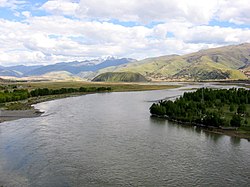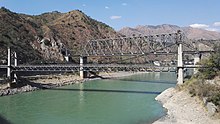Yalong River
| Yalong River | |
|---|---|
 The Yalong River atGanzi | |
 Map of the Yalong River drainage basin | |
| Location | |
| Country | China |
| Physical characteristics | |
| Source | Bayan Har Mountains |
| • coordinates | 34°12′27″N97°36′24″E/ 34.20750°N 97.60667°E |
| • elevation | 4,920 m (16,140 ft) |
| Mouth | Yangtze River |
• location | Panzhihua,Sichuan |
• coordinates | 26°36′20″N101°48′5″E/ 26.60556°N 101.80139°E |
• elevation | 985 m (3,232 ft) |
| Length | 1,571 km (976 mi)[1] |
| Basin size | 128,444 km2(49,593 sq mi)[2] |
| Discharge | |
| • location | Confluence |
| • average | 1,810 m3/s (64,000 cu ft/s)[3] |
| Basin features | |
| Tributaries | |
| • left | Anning |
| • right | Muli |

TheYalong River(Chinese:Nhã lung giang,pYǎlóngjiāng,wYa-lung Chiang,IPA[jàlʊ̌ŋ tɕjàŋ]), orNyag Chu(Tibetan:ཉག་ཆུ་,zNyag Qu), is a major tributary river of theYangtze RiverinSouthwest China.With a length of 1,571 km (976 mi), the Yalong River flows from north to south through theHengduan Mountainsin westernSichuan Province.
Course
[edit]The Yalong has its source in theBayan Har Mountainson theTibet–Qinghai PlateauinChindu County,Yushu,Qinghai,where it is known as theZa Qu(Chinese:Trát khúc).[4]Flowing southeasterly, the Yalong gradually turns south atGarzêand travels between theShaluli Mountainsto the west and theDaxue Mountainsto the east.[5]The Yalong River channel runs through a deep gorge for much of its length south of Garzê. The southernSichuan-Tibet Highwaycrosses the Yalong atYajiangin the middle of the river's course. InLiangshan Prefecture,the river wraps 150 km (93 mi) around theJinping Mountainscreating the Jinping Bend.[5]Here, water from the Yalong River has been diverted under the mountains as part of theJinping-II Damhydroelectricproject. The Yalong meets the main stem of the Yangtze (Jinsha) River inPanzhihua,Sichuan.[6]
History
[edit]The upper reaches of the Yalong have traditionally been inhabited by the Tibetan nomads of the historic region ofKham.The lower course of the Yalong is deeply incised and is not conducive to human habitation. The lower course of the Yalong was historically the western limit of Chinese influence in the region.[7]
Dams
[edit]Since the 1980s, the Yalong has been heavily developed forhydroelectricpower.[7]A total of 23 dams are completed, under construction, or planned for the river. Those dams are listed below from downstream to upstream.[8][9]
- Tongzilin Dam– Under construction, 600 MW
- Ertan Dam– Completed, 3,300 MW
- Guandi Dam– Completed, 2,400 MW
- Jinping 2 Dam– Completed, 4,800 MW
- Jinping 1 Dam– Completed, 3,600 MW,tallest dam in the world
- Kala Dam– Programmed, 1,060 MW
- Yangfanggou Dam– Programmed, 2,200 MW
- Mengdigou Dam– Programmed, 1,700 MW
- Lenggu Dam– Planned, 2,300 MW
- Yagen Dam– Programmed, 1,500 MW
- Lianghekou Dam– Completed, 3,000 MW
- Gongbagou Dam– Planned, 500 MW
- Gongke Dam– Planned, 400 MW
- Xinlong Dam– Planned, 500 MW
- Yingda Dam– Planned, 500 MW
- Tongha Dam– Planned, 200 MW
- Geni Dam– Planned, 200 MW
- Ada Dam– Planned, 250 MW
- Reba Dam– Planned, 250 MW
- Renqingling Dam– Planned, 300 MW
- Wenbosi Dam– Planned, 150 MW
- Danikanduo Dam– Planned, 7.2 MW
- Yangri Dam– Planned, 1 MW
References
[edit]- ^Shen, Zhiliang (23 January 2019).Studies of the Biogeochemistry of Typical Estuaries and Bays in China.ISBN9783662581698.
- ^Shen, Zhiliang (23 January 2019).Studies of the Biogeochemistry of Typical Estuaries and Bays in China.ISBN9783662581698.
- ^Shen, Zhiliang (23 January 2019).Studies of the Biogeochemistry of Typical Estuaries and Bays in China.ISBN9783662581698.
- ^Qinghai Sheng Dituce(in Chinese). China: Star Map Press. 2011.ISBN9787547107300.
- ^abAtlas of China.Beijing, China: SinoMaps Press. 2006.ISBN9787503141782.
- ^Sichuan Sheng Dituce(in Chinese). China: Star Map Press. 2012.ISBN9787547109151.
- ^ab"Yalong River".Britannica.Encyclopædia Britannica.Retrieved17 January2021.
- ^Dong, Luan."INTERACTIVE: Mapping China's" Dam Rush "".Wilson Center.Retrieved15 June2014.
- ^"The Last Report on China's Rivers".China's Rivers Report. March 2014.Retrieved15 June2014.
